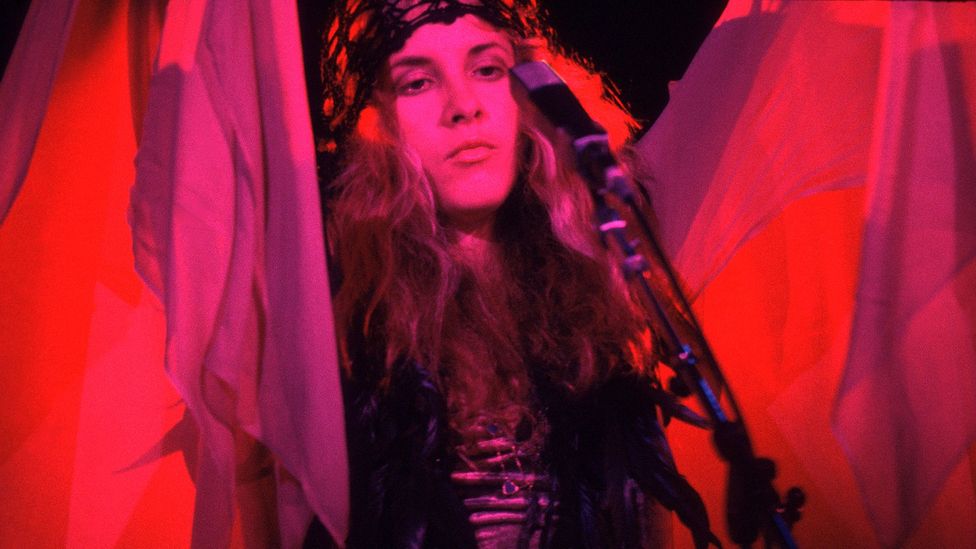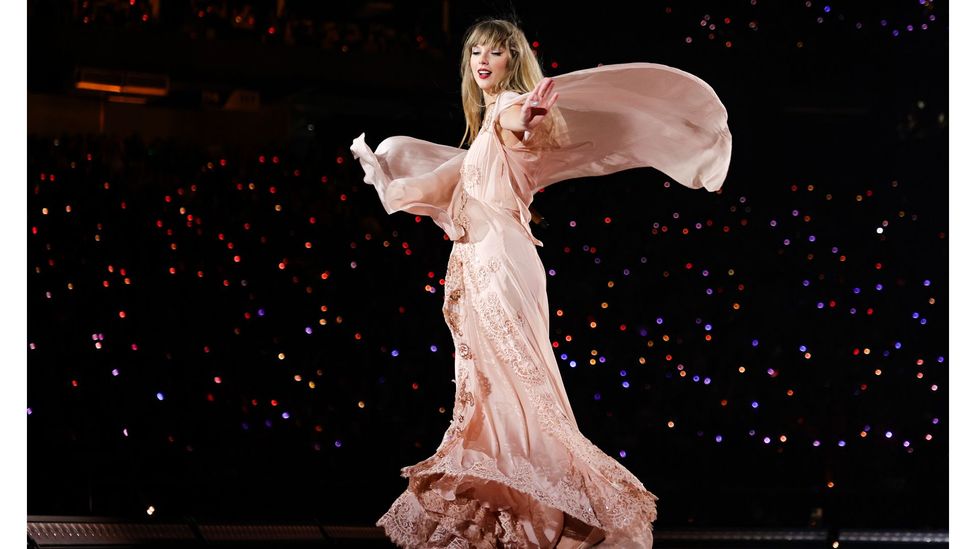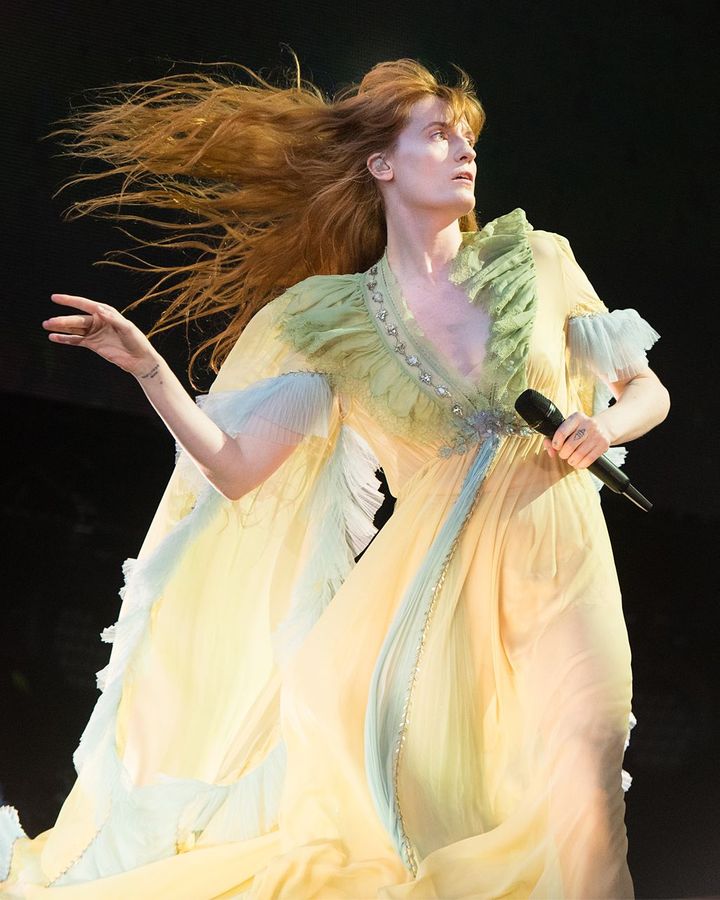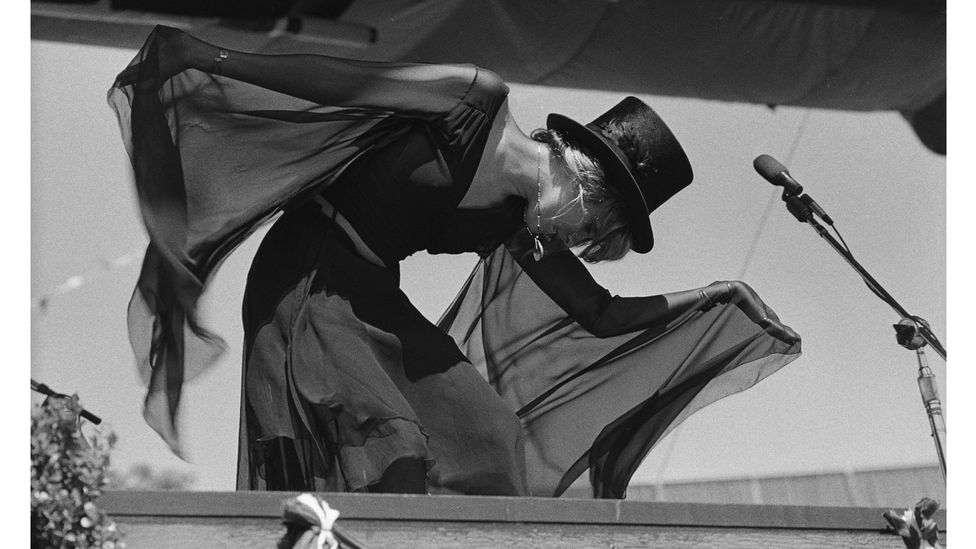Of all the rock ‘n’ roll legends who have played Glastonbury over its 53-year history, one much-loved band hasn’t appeared on the bill. Fleetwood Mac have never made the pilgrimage to Worthy Farm. Even so, when the gates to Glastonbury opened a few days ago, the band’s Stevie Nicks will certainly have been there in spirit. Or rather, in the form of all the many festival-goers dressed in her signature look of flowing maxi dresses, billowing sleeves, kimonos, shawls and layers of chiffon, velvet and lace.
More like this:
– A wild tale of rock ‘n’ roll excess
– Rise of the ‘no-wash’ movement
– How the ‘naked’ look took over
Modern festival fashion has long leaned into the bohemian look – it’s 20 years since Kate Moss arrived at Glastonbury in a pair of fringed suede boots and loose pink kaftan and scarf-style belt. Then, soon after, Sienna Miller’s coin belts, cowboy boots and floppy hats also became summer staples. “In the early 2000s, 70s bohemian-inspired fashion became inextricably linked with summer in the public’s minds, likely due to the high press attention on celebrity attendees,” says fashion and cultural historian Laura McLaws Helms. “Since then, every summer, aspects of the aesthetic return to fashion. It now feels that part of having the ‘festival experience’ is wearing a bohemian-inspired look.”

In the 1970s, Fleetwood Mac’s singer Stevie Nicks blazed a trail of long, floaty dresses and diaphanous sleeves (Credit: Getty Images)
But this summer’s dominant style is about more than a token flower crown. Whether it’s the plethora of patchwork, flares, fringed jackets and crocheted tops that recall communal 1970s living in Laurel Canyon, California, or the more gothic-inspired looks of the TikTok trend labelled “whimsigoth”, the influence of retro bohemia on 2023 style is undeniable. And it’s those who weren’t even close to being born when the look’s go-to soundtrack – Fleetwood Mac’s Rumours – was released in 1977, who are digging it the most.
Having mined 1990s fashion for all it’s worth, Gen Z are now going further back in time for inspiration. “Younger generations have a penchant for all things nostalgic, and love looking to older style icons and influencers,” says Heather Ibberson, retail analyst at Edited, who has been tracking the rise of the 70s boho trend in recent months. She says its mix-matched aesthetic appeals to a generation that has embraced vintage and second-hand fashion.
It is also the Daisy Jones effect. Taylor Jenkins Reid’s 2019 novel Daisy Jones & the Six, which tells the story of the rise and fall of a fictional 70s band – heavily inspired by Fleetwood Mac – saw sales soar during lockdown, thanks to readers sharing their love for it on TikTok. Earlier this year, a much-anticipated TV adaptation of the book aired on Prime Video and created even more of a frenzy on the platform (the hashtag #daisyjonesandthesix has 1.3bn views) – with the show’s fashion as much of a draw as its storyline.
The show’s outfits are the work of costume designer Denise Wingate who, besides having 30 years’ experience working in film and television, also toured with The Bangles as their stylist in the early 80s. “This was my dream job,” she tells BBC Culture. “When I read [Jenkins’] book I knew I had to do it. I was born and raised in LA, very involved in the music scene, I just felt it was my era. I knew the world.”
Wingate was adamant she didn’t want it to look like a “70s costume party”. “My original vision boards were all based on real people very much of the Laurel Canyon era and very documentary style.” The mountainous neighbourhood of Laurel Canyon in the Hollywood Hills region of Santa Monica became an epicentre of countercultural attitudes in the mid to late 60s and early 70s, and was home to many of LA’s rock musicians. Inspiration for the TV series’ costumes came from pictures of The Mamas and Papas, Frank Zappa, Cher, Linda Ronstadt and Fleetwood Mac. “Of course, we were influenced by Stevie Nicks,” she says.

TV series Daisy Jones & the Six, starring Riley Keough, captured the iconic boho chic of 1970s California (Credit: Alamy)
The goal was a look that was vintage yet contemporary. “I felt like it would be introducing a whole new generation to an era they may not even be aware of, or at least of the fashion, and I wanted kids to be able to say ‘Wow, I want to look like that’.”
According to research by Edited, Pinterest searches for “retro 70s fashion” peaked in the week following the show’s premiere. Fashion brand Free People launched a special Daisy Jones & the Six collection, while Levi’s produced a denim halter top – inspired by a similar item worn in the show – which quickly sold out.
Wingate has been overwhelmed by the reaction to the show from young fans, who tag her on social media with their own takes on the looks. “They send me pictures on Instagram and send me their TikTok videos where they’ll do this little fashion show with one of the songs.”
Why does she think the 70s look still strikes such a chord? “I think there’s a nostalgia with the music and I think maybe it’s a throwback to an earlier, pre-computer time, where everything was just a little more natural and organic.”
The story’s lead character Daisy, played in the show by Riley Keough, is the archetypal free-spirited woman, who lives life on her terms – and has a wardrobe that’s just as exciting and eclectic.
Go your own way
“The 1960s and 1970s have been highly romanticised in the press and in people’s minds, with the music playing a key role in the nostalgia for that time,” says Helms. “The rock stars, the women, the fans, all of their fashions – there is an inherent coolness and seeming authenticity. They all seem more real and more authentic than the highly styled celebrities of today.”

During the Folklore section of her current Eras tour, Taylor Swift has been sporting a selection of 70s-inspired dresses on stage (Credit: Getty Images)
Bohemian or boho fashion has its roots in the hippy movement of the late 1960s. “Informed by the 19th and early 20th-Century obsession with the adventurous young adults from the US and UK who ventured to North Africa or the old Silk Road, bringing back with them exotic-seeming traditional garments,” says Helms. “Once home, they mixed these items with jeans and antique clothes picked up at markets, creating a ragbag, ethnic aesthetic that marked them as not being part of ‘normal’ society – through their clothes, music and lifestyle they were forming a counterculture. Their clothing choices were a visible sign to the rest of society of their beliefs – politically, socially, environmentally.”
What started out as an act of rebellion and individuality soon became mainstream, influencing designers and mass market manufacturers.
In the 70s, stars like Stevie Nicks put their own spin on the look – with a style described by the LA Times as “an amalgam of goth hippie, bohemian Californian girl and Victorian priestess”.
It’s an aesthetic that’s since influenced Florence Welch, and also Taylor Swift – who has been wearing a selection of Stevie-esque, floaty chiffon dresses for the Folklore section of her current Eras tour.
Nicks is also a big inspiration for the “whimsigoth” trend that took hold on TikTok last year and is still going strong – a look that blends 70s bohemia with more gothic influences from the 80s and 90s.
“Whimsigoth is looking to the more witchy trends of the 1990s, which in turn were inspired by Stevie Nicks’ whole style oeuvre – from her late 1970s more ballerina-inspired styles to the witchy romanticism of 1983’s The Wild Heart album to the more ornate Victorian witchiness of Stevie in the late 1980s and 90s,” says Helms.
With all these looks, there’s an element of dress-up that’s appealing to new generations, says Ibberson. “With aesthetics like whimsigoth, and there’s also grunge fairycore which is quite similar, they all have this whimsical element. I think that’s what draws [Gen Z] to it. It’s a lot more playful.”

UK artist Florence Welch has been influenced by the 70s rock-goddess look, with her romantic, floaty dresses and long, loose hair (Credit: Getty Images)
But there could be a deeper connection, too. Stevie Nicks’ gravitation towards anything black and flowing meant she was forced to deny she was a witch – but has always been open about her love of all things magical and mystical, something she has in common with Gen Z, who are driving growth in the crystal and astrology markets. They’re also chasing some of the same recreational highs as their 70s’ counterparts, with the use of psychedelic stimulants and marijuana soaring in young adults.
“The 70s is obviously the hippy era and associated with this feeling of free spiritedness and love, and the younger generation today definitely have an interest in spirituality, as well as living more sustainably,” says Ibberson.
Thrifting has always been a part of the boho look, even back in the 70s. “We forget that people in the 70s were wearing vintage clothes too, they were buying things in antique stores and flea markets,” says Wingate, who scoured markets, vintage shops and online sites like Etsy and Poshmark when sourcing the outfits for Daisy Jones & The Six.
“A lot of the stuff I used on Riley, who plays Daisy, is from the 20s and 30s, these kimono gowns and beautiful velvet bed jackets, which were falling apart but that to me was realistic. People in Laurel Canyon who didn’t have a lot of money, they were going to the vintage stores or raiding their grandma’s closet.”
Research by thredUP shows that the secondhand clothing market in the US grew at five times the rate of standard retail last year, with online resale the fastest growing sector of the market – largely driven by Gen Z. The cost of living is a major factor for buying preloved garments today, but Ibberson says it’s also about wearing outfits no one else has. “There are cheap fast fashion brands, but what you’re getting is the same thing that everyone will be wearing. The attraction of thrifting is that individuality.”

Stevie Nicks frequently gravitated towards black outfits – a look that has been a major inspiration for the ‘whimsigoth’ TikTok trend (Credit: Getty Images)
Helms isn’t convinced that eco-consciousness is driving the trend. “Personally, I feel that this plays quite a small part – overall people are primarily attracted to the aesthetic and the majority desire to achieve that aesthetic through whatever means necessary, meaning that fast fashion contributes most of the garments worn in creating boho, festival looks.”
Authentic garments or not, it seems there’s something undeniably attractive about tapping into a past era that seemed simpler – particularly when viewed through rose-tinted spectacles.
“Maybe it wasn’t, but something always seems better in retrospect, especially if you haven’t lived it,” says Wingate. “Even for the kids that are too young to remember it, it seems like the good old days. There’s so much division in the world and so much drama now, maybe there’s something about looking back at an easier time where it was just sex, love and rock ‘n’ roll.”